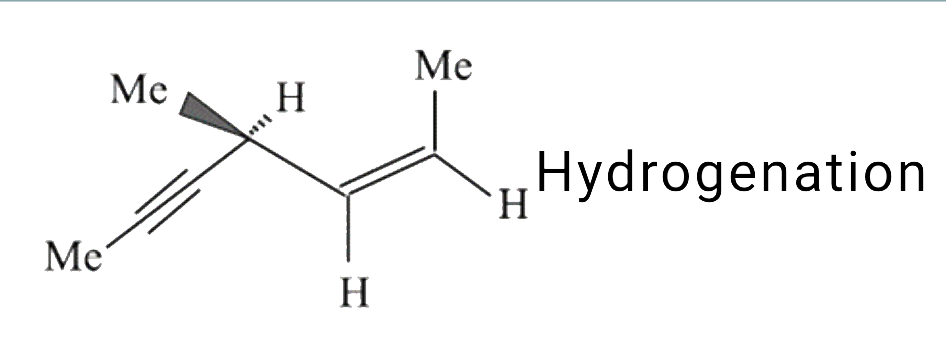The reaction of acetone and ammonia in presence of sodium cyanoborohydride gives_____
To solve the question regarding the reaction of acetone and ammonia in the presence of sodium cyanoborohydride, we can break it down into a series of steps:
Step 1: Identify the Reactants
- The reactants in this reaction are acetone (a ketone) and ammonia (NH3).
Step 2: Understand the Reaction Mechanism
- When acetone reacts with ammonia, it undergoes a condensation reaction to form an imine. The carbonyl group (C=O) of acetone reacts with the amine group (NH2) from ammonia, leading to the formation of an imine (C=N).
Step 3: Formation of the Imine
- The reaction can be represented as follows:
Acetone+Ammonia→Imine+H2O
- The structure of the imine formed is:
C(CH3)2=N-H
This is called an imine.
Step 4: Reduction of the Imine
- Sodium cyanoborohydride (NaCNBH3) acts as a reducing agent. It reduces the imine to an amine.
- The reduction can be represented as:
Imine+NaCNBH3→Isopropylamine
- The final product after reduction is isopropylamine (or propane-2-amine).
Step 5: Conclusion
- Therefore, the final product of the reaction of acetone and ammonia in the presence of sodium cyanoborohydride is isopropylamine.
Final Answer:
The reaction of acetone and ammonia in the presence of sodium cyanoborohydride gives isopropylamine (propane-2-amine).
---
- The reactants in this reaction are acetone (a ketone) and ammonia (NH3).
- When acetone reacts with ammonia, it undergoes a condensation reaction to form an imine. The carbonyl group (C=O) of acetone reacts with the amine group (NH2) from ammonia, leading to the formation of an imine (C=N).
- The reaction can be represented as follows:
Acetone+Ammonia→Imine+H2O
- The structure of the imine formed is:
C(CH3)2=N-H
This is called an imine.
- Sodium cyanoborohydride (NaCNBH3) acts as a reducing agent. It reduces the imine to an amine.
- The reduction can be represented as:
Imine+NaCNBH3→Isopropylamine
- The final product after reduction is isopropylamine (or propane-2-amine).
- Therefore, the final product of the reaction of acetone and ammonia in the presence of sodium cyanoborohydride is isopropylamine.
The reaction of acetone and ammonia in the presence of sodium cyanoborohydride gives isopropylamine (propane-2-amine).
Topper's Solved these Questions
- ORGANIC COMPOUNDS CONTAINING NITROGENBOOK - PRADEEPCHAPTER - ORGANIC COMPOUNDS CONTAINING NITROGENEXERCISE - CONCEPTUAL QUESTIONS
19 Videos
- ORGANIC COMPOUNDS CONTAINING NITROGENBOOK - PRADEEPCHAPTER - ORGANIC COMPOUNDS CONTAINING NITROGENEXERCISE - NCERT QUESTIONS AND EXERCISES WITH ANSWERS (NCERT INTEX SOLVED QUESTIONS)
5 Videos
- ORGANIC COMPOUNDS CONTAINING NITROGENBOOK - PRADEEPCHAPTER - ORGANIC COMPOUNDS CONTAINING NITROGENEXERCISE - TEST YOUR GRIP MULTIPLE CHOICE QUESTIONS
22 Videos
- HALOALKANES AND HALOARENESBOOK - PRADEEPCHAPTER - HALOALKANES AND HALOARENESEXERCISE - IMPORTANT QUESTIONS FOR BOARD EXAMINATION
22 Videos
- P-BLOCK ELEMENTS BOOK - PRADEEPCHAPTER - P-BLOCK ELEMENTS EXERCISE - IMPORTANT QUESTIONS FOR BOARD EXAMINATION
25 Videos
Similar Questions
Knowledge Check
Reduction of acetone in the presence of sodium borohydride gives
A1-propanolB2-propanolCPropeneDn-propaneReaction of formadehyde and ammonia gives
Ahexamethylene tetramineBbakeliteCureaDtriethylene tetramineReaction of formaldehyde and ammonia gives
Ahexamethylene tetramineBbakeliteCureaDtriethylene tetramine.
The reaction of acetone with PCI5 gives
View SolutionThe reaction of sodium acetate and sodalime gives
View Solution Hydrogenation of the above compound in the presence of sodium in liquid ammonia gives -
Hydrogenation of the above compound in the presence of sodium in liquid ammonia gives -
View SolutionEthyl chloride on reaction with chlorobenzene in presence of Sodium and ether gives:
View SolutionThe reaction of chloroform with acetone gives
View Solution
